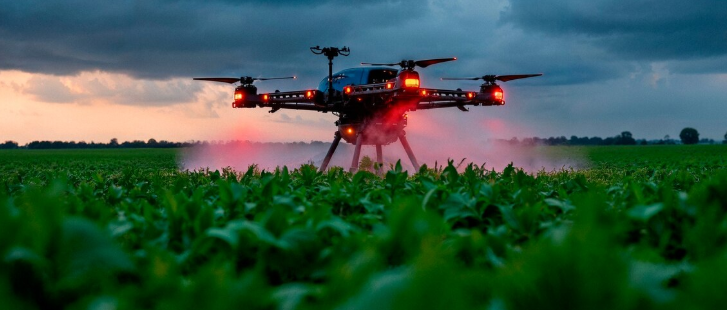Across sun-drenched landscapes where tractors hum and crops sway in the breeze, a transformative shift is quietly taking root. The traditional image of farm labor, defined by calloused hands and sun-weathered faces, is being subtly rewritten by the rise of robotics and automation. This blog delves into the evolving landscape of the future of farm labor, exploring the transformative potential of these technologies, their impact on the agricultural workforce, and the opportunities they present for a more efficient, sustainable, and resilient food system.

From Muscle to Machine: Redefining Physical Labor
For centuries, farm labor has been synonymous with backbreaking physical exertion. Sowing seeds, tending crops, and harvesting bounty involved long hours under the scorching sun, demanding a grueling dedication to manual tasks. But robotics and automation are ushering in a new era, one where tireless machines take on the burdens of repetitive physical labor. Imagine autonomous tractors ploughing fields with laser-guided precision, tirelessly sowing seeds and meticulously weeding rows without fatigue. Envision robotic harvesters equipped with dexterous appendages, gently picking delicate fruits and vegetables, minimizing harvest-time losses and ensuring optimal quality. This future of farm labor, where machines handle the heavy lifting, promises to alleviate the physical demands of farming, potentially attracting a wider talent pool and improving the well-being of agricultural workers.
Beyond Muscle: Precision and Efficiency Through Sensors and AI
Farm labor of the future goes beyond simply replacing physical tasks with machines. It’s about harnessing the power of sensors, data analysis, and artificial intelligence (AI) to optimize farming practices and boost efficiency. Imagine sensors embedded in soil monitoring moisture levels, nutrient deficiencies, and potential pest infestations in real-time. Envision AI-powered software analyzing this data and guiding planting schedules, irrigation decisions, and even targeted pest control measures with unparalleled precision. This data-driven future empowers farmers to make informed decisions, maximizing resource utilization, minimize waste, and ensuring optimal yields with less reliance on traditional, often imprecise, methods.
Resilience in the Fields: Weathering the Storms with Automation
Beyond Yield: Cultivating a Sustainable Future with Robot Hands
While maximizing yields is crucial, the future of farm labor is not solely focused on production. It’s about fostering a sustainable future for our planet. Imagine robotic weeding systems equipped with laser technology or targeted bioherbicides, precisely eliminating unwanted plants while minimizing harm to beneficial insects and soil health. Envision autonomous fertilizer applicators applying customized nutrient blends based on soil needs, reducing chemical run-off and protecting water quality. This sustainability-focused future, powered by robotics and automation, helps farmers minimize their environmental footprint, ensuring long-term agricultural sustainability and safeguarding the planet’s precious resources for future generations.
Connecting Farms to the Cloud: Collaborative Intelligence in the Fields
The future of farm labor thrives on collaboration and knowledge sharing. Imagine farmers across continents sharing data on specific crop varieties, soil types, and regional weather patterns through secure cloud platforms. Envision collaborating with agricultural experts and researchers around the globe, analyzing combined datasets fueled by robotics and automation to identify emerging trends, develop best practices, and troubleshoot challenges faced by diverse agricultural landscapes. This collaborative network fosters innovation, accelerates problem-solving, and empowers farmers to learn from each other’s successes, regardless of geographical location. With every shared insight, the agricultural community strengthens, propelling the industry towards a brighter future where future farm labor thrives on the power of shared knowledge.
A Glimpse into the Future: Innovation Transforming the Landscape (Continued)
The world of robotics and automation in agriculture is constantly evolving, with cutting-edge advancements emerging seemingly every day. Imagine intelligent robotic assistants performing complex tasks like pruning fruit trees, conducting on-site soil analysis, or even harvesting delicate grapes with gentle dexterity. Envision AI-powered software predicting potential crop diseases and suggesting preventive measures before symptoms even appear. This future of farm labor promises even greater efficiency, sustainability, and resilience, further revolutionizing the way we cultivate and nurture our crops.
Additional Resources
Categories
Latest Post’s
FAQs
How are robotics and automation redefining farm labor?
Robotics and automation are redefining farm labor by shifting the focus from strenuous manual tasks to more technologically advanced roles. Autonomous tractors, robotic harvesters, and automated weeding systems take over repetitive and physically demanding jobs, allowing the agricultural workforce to focus on managing technology, analyzing data, and strategic decision-making.
What specific tasks can agricultural robots perform?
Agricultural robots are becoming increasingly versatile. They can perform a wide range of tasks, including:
- Precision planting: Sowing seeds with pinpoint accuracy.
- Targeted weeding: Using lasers or precise sprayers to remove weeds without disturbing crops or using excessive chemicals.
- Automated harvesting: Gently picking delicate fruits and vegetables at optimal ripeness.
- Data collection: Monitoring soil health, crop growth, and pest presence using sensors and AI.
How does automation improve farm efficiency and productivity?
Automation significantly improves efficiency and productivity by enabling 24/7 operations without human fatigue. Robotic systems work with a high degree of precision, reducing errors and optimizing resource use. For instance, they can apply fertilizers and pesticides only where needed, leading to better yields and lower costs.
What is the role of AI and data in the future of farm labor?
AI and data are central to the future of farm labor. Sensors collect real-time data on everything from soil moisture to plant health. AI-powered software then analyzes this information to guide automated machines and provide farmers with actionable insights. This data-driven approach allows for more informed decisions and a more resilient farming system.
Will robotics and automation lead to job losses in agriculture?
The rise of robotics and automation will lead to a shift, rather than a total elimination, of jobs. While some low-skilled, manual labor roles may be displaced, new opportunities will emerge for a workforce skilled in operating, maintaining, and repairing agricultural robots and data systems. The future workforce will be more focused on technology and data management.
How do these technologies contribute to sustainability?
Robotics and automation contribute to sustainability by enabling precision agriculture. This includes the targeted application of water and nutrients, which reduces waste and prevents chemical runoff. Furthermore, robotic weeding systems can lessen the need for herbicides, protecting soil health and biodiversity.
What are the main challenges to adopting agricultural robotics?
Key challenges include the high initial investment cost of robotic equipment, the need for robust rural internet infrastructure to support data exchange, and the requirement for farmers and workers to acquire new technical skills. These factors can create a barrier to entry, particularly for smaller farms.
How will automation change the skills needed for farm work?
The skills required for farm work are evolving from physical strength and manual labor to technical and analytical skills. Future farm workers will need to be proficient in data analysis, software management, and robotics maintenance to effectively operate the new automated systems.
How do autonomous systems help farms deal with climate change?
Autonomous systems can help farms build resilience against climate change by adapting to a range of conditions. For example, they can operate in extreme heat and other weather conditions that might be unsafe for humans. Additionally, they can provide real-time data to help farmers adjust to unpredictable weather patterns and manage resources like water more effectively.
How can smaller farms afford and access these new technologies?
As technology becomes more widespread, the costs are expected to decrease. Additionally, new business models, such as leasing services and “as-a-service” platforms, are making it possible for smaller farms to access sophisticated equipment without a massive upfront investment. Government subsidies and collaborative initiatives can also help democratize access to these technologies.


